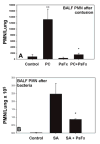Mitochondrial damage-associated molecular patterns from fractures suppress pulmonary immune responses via formyl peptide receptors 1 and 2
- PMID: 25757111
- PMCID: PMC4357317
- DOI: 10.1097/TA.0000000000000509
Mitochondrial damage-associated molecular patterns from fractures suppress pulmonary immune responses via formyl peptide receptors 1 and 2
Abstract
Background: No known biologic mechanisms link tissue injury with pneumonia (PNA). Neutrophils (PMNs) are innate immune cells that clear bacteria from the lung by migration toward chemoattractants and killing bacteria in neutrophil extracellular traps (NETs). We predicted that tissue injury would suppress PMN antimicrobial function in the lung. We have also shown that mitochondria-derived damage-associated molecular pattern molecules from the bone can alter PMN phenotype and so hypothesized that formyl peptides (FPs) from fractures predispose to PNA by suppressing PMN activity in the lung.
Methods: Animal studies involved the following. (1) Rats were divided into three groups (10 per condition) as follows: (a) saline injection in the thigh (b) Staphylococcus aureus (SA, 3 × 10) injected intratracheally, or (c) pseudofracture (PsFx; bone supernatant injected in the thigh) plus intratracheally injected SA. (2) Rats were divided into four groups as follows: (a) control, (b) pulmonary contusion (PC), (c) PsFx, and (d) PC + PsFx. Bronchoalveolar lavage was performed 16 hours later. Clinical studies involved the following. (3) Human bone supernatant was assayed for its FP-receptor (FPR) stimulation. (4) Trauma patients' PMN (n = 32; mean ± SE Injury Severity Score [ISS], 27 ± 10) were assayed for chemotaxis (CTX) or treated with Phorbol 12-myristate 13-acetate (PMA, Phorbol ester) and analyzed for NET formation.
Results: In the animal studies, (1) SA was rapidly cleared by the uninjured mice and PsFx markedly suppressed lung bacterial clearance (p < 0.01). (2a) PC induces PMN traffic to the lung, but PsFx decreases PC-induced PMN traffic (p < 0.01). (2b) SA increased bronchoalveolar lavage PMN, and PsFx decreased that influx (p < 0.01). In the clinical studies, (3) bone supernatant activates PMN both via FPR-1 and FPR-2. (4) Trauma decreases PMN CTX to multiple chemokines. Circulating PMNs show NETs spontaneously after trauma, but maximal NET formation is markedly attenuated.
Conclusion: Fractures may decrease lung bacterial clearance because FP suppresses PMN CTX to other chemoattractants via FPR-1/2. Trauma activates NETosis but suppresses maximal NETosis. Fractures decrease lung bacterial clearance by multiple mechanisms. PNA after fractures may reflect damage-associated molecular pattern-mediated suppression of PMN antimicrobial function in the lung.
Figures






References
-
- Michetti CPFS, Ferguson PL, Cook A, Moore FO, Gross R. Ventilator-associated pneumonia rates at major trauma centers compared with a national benchmark: A multi-institutional study of the aast. The Journal of Trauma and Acute Care Surgery. 2012;72:1165–1173. - PubMed
-
- Eckert MJDK, Reed RL, 2nd, Santaniello JM, Poulakidas S, Esposito TJ, Luchette FA. Urgent airways after trauma: Who gets pneumonia? The journal of Trauma. 2004;57:750–755. - PubMed
Publication types
MeSH terms
Substances
Grants and funding
LinkOut - more resources
Full Text Sources
Medical
Miscellaneous

